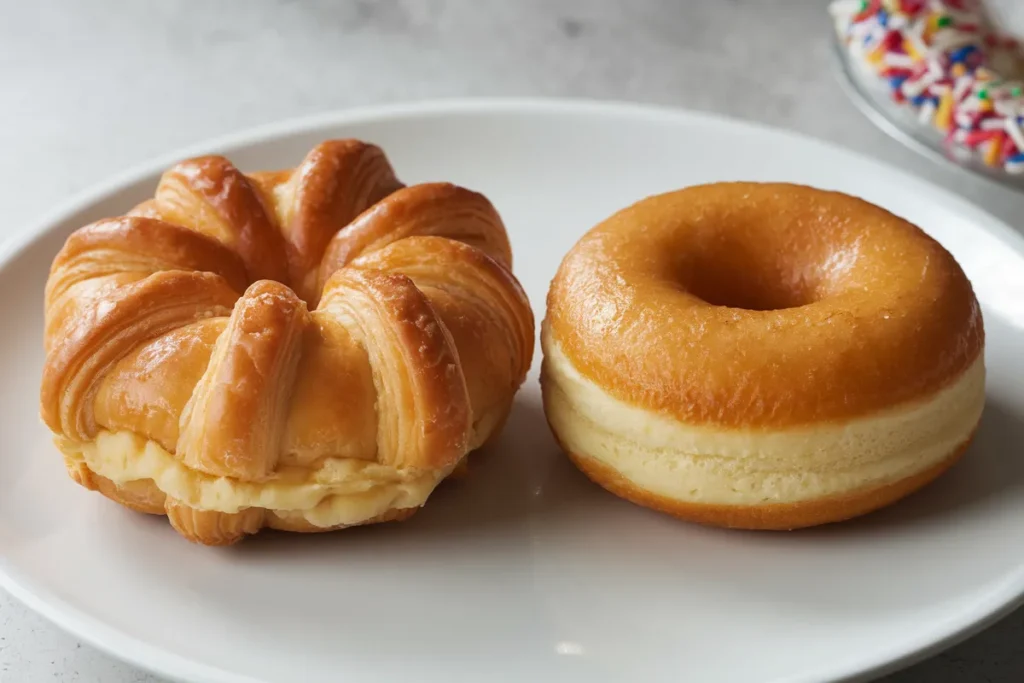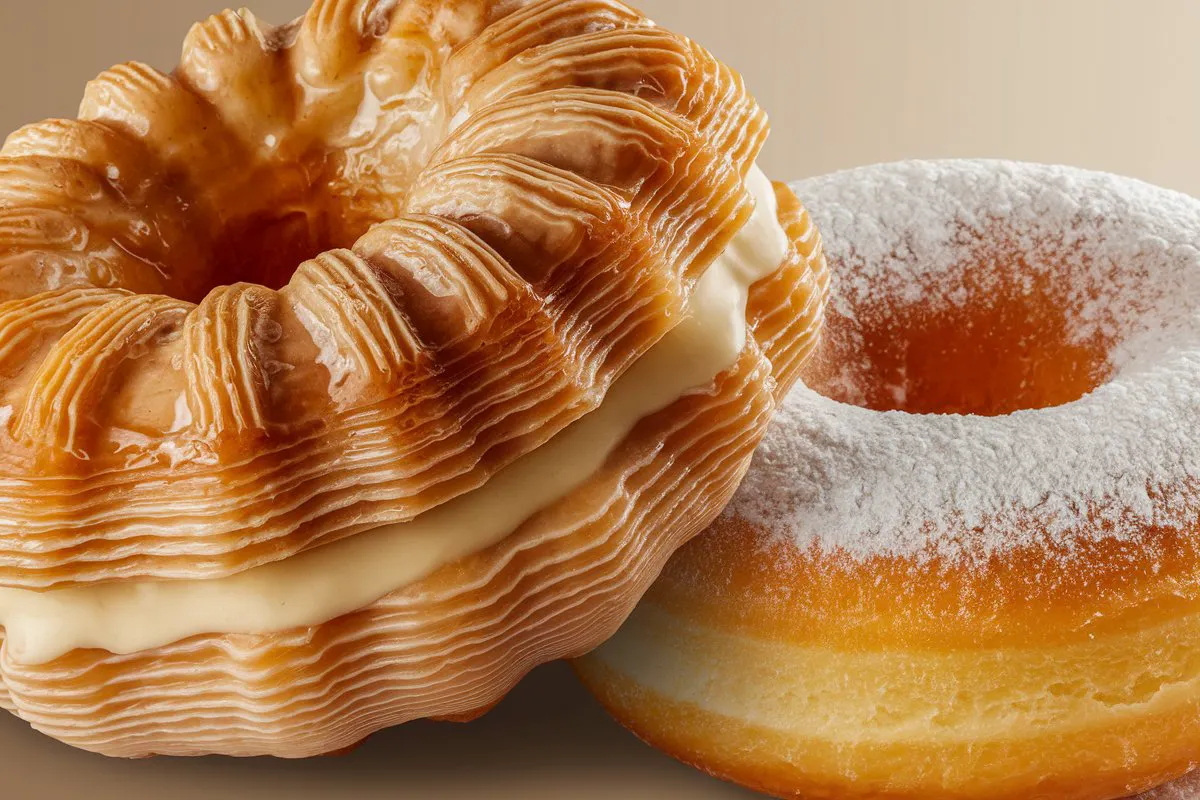In the ever-evolving world of pastries, few treats have captured the collective imagination quite like the doughnut and the Cronut. These two pastries have each carved out a special place in the hearts (and stomachs) of dessert lovers worldwide, yet they offer entirely different experiences. But what exactly sets them apart? Let’s dive into the sweet, flaky, and delicious details to answer the burning question: What is the difference between a Cronut and a doughnut?
Introduction
The Cronut and Doughnut Phenomenon: A Sweet Sensation
When it comes to comfort food, few things can rival the simple pleasure of a doughnut. It’s a treat that’s been around for centuries, beloved for its soft, fluffy texture and the way it pairs perfectly with a hot cup of coffee. Enter the Cronut, a hybrid pastry that’s taken the world by storm since its introduction in 2013. The Cronut combines the best of both worlds: the buttery layers of a croissant and the sweet, deep-fried goodness of a doughnut. Created by Dominique Ansel, the Cronut quickly became a cultural sensation, inspiring long lines and countless imitators.
For a deeper look into the historical evolution of the doughnut, the article The History of Doughnuts is a great resource, offering insight into how this beloved pastry has changed over time.
The Origins and History of Doughnuts: A Classic Treat
The history of the doughnut is as rich as the pastry itself. Believe it or not, the roots of the doughnut can be traced back to ancient Greece and Rome, where people enjoyed simple fried dough as a sweet treat. However, the modern doughnut that we know and love today began to take shape in the hands of Dutch settlers in America. These settlers brought their recipe for olykoeks (oily cakes), which were essentially sweet balls of dough fried in oil. Over time, this evolved into the ring-shaped doughnuts we recognize today, complete with a hole in the middle—a feature added to ensure even cooking.
As doughnuts grew in popularity, they began to diversify, taking on a variety of forms and flavors. From the classic glazed doughnut to more elaborate versions like the Boston cream and jelly-filled, there’s a doughnut to suit every taste.
The Birth of the Cronut: A Modern Pastry Marvel
While the doughnut has ancient roots, the Cronut is a decidedly modern creation. This innovative pastry was born in the kitchen of Dominique Ansel Bakery in New York City in 2013. Inspired by the flaky layers of a croissant and the sweet, deep-fried appeal of a doughnut, Ansel set out to create something entirely new—and he succeeded. The Cronut quickly became a worldwide sensation, with people lining up around the block to get their hands on one.
Today, the Cronut remains a popular choice for those looking to try something a little different from the usual pastry fare. For more on the origin and innovation behind this unique pastry, visit the official Dominique Ansel Bakery.
Comparative Analysis: Cronut vs Doughnut
Appearance and Texture: Cronut and Doughnut Visual Differences
At first glance, you can spot the differences between a doughnut and a Cronut. The doughnut is typically ring-shaped, although you’ll also find varieties like filled doughnuts, which come in a more rounded shape. The texture of a doughnut is soft and fluffy, achieved through a combination of yeast, sugar, and butter. This gives it a satisfying chewiness that’s complemented by a sweet glaze or filling. The outer layer of the doughnut can vary—from a simple sugar dusting to a thick layer of icing or sprinkles.

In contrast, the Cronut boasts a spiral shape that’s reminiscent of a croissant. The dough used to make Cronuts is laminated with butter, creating multiple thin, flaky layers. When you bite into a Cronut, the outer layers shatter lightly, giving way to a tender, buttery interior. This combination of crispy and soft textures is what makes the Cronut so unique and appealing.
Taste and Flavor Profiles: The Cronut and Doughnut Experience
The flavor profile is another area where doughnuts and Cronuts diverge significantly. Doughnuts are all about simplicity and versatility. The dough itself is mildly sweet, providing a blank canvas for a wide range of flavors. The most popular doughnuts are glazed, but you’ll also find chocolate-covered, sugar-coated, and even cream-filled varieties. Whether you prefer something classic like a glazed doughnut or something more adventurous like a maple bacon doughnut, there’s a flavor out there for everyone.
Cronuts, on the other hand, offer a more complex flavor experience. The dough’s buttery richness, combined with various fillings and glazes, creates a multi-layered taste that is both indulgent and sophisticated. Popular Cronut flavors include chocolate ganache, vanilla custard, and maple glaze, each adding a distinct character to the pastry. The filling inside the Cronut often contrasts with the outer glaze, providing a delightful balance of flavors with every bite.
Cultural and Culinary Impact: The Influence of Cronuts and Doughnuts
When it comes to cultural impact, both doughnuts and Cronuts have made significant marks. Doughnuts have been a staple in American culture for decades, often associated with morning coffee and a sense of comfort. They’re a common sight at breakfast tables, office meetings, and police stations alike, and they hold a nostalgic place in many people’s hearts. The classic doughnut is a symbol of simplicity and indulgence, a treat that brings a little sweetness to the everyday.
Cronuts, however, represent something more modern and experimental. Their rise to fame marked a shift in how we view pastries, blending traditional techniques with innovative flair. The Cronut craze also sparked a wave of hybrid pastries, where bakers began experimenting by combining different textures and flavors to create something entirely new. This trend has led to the creation of countless new pastries, each with its own unique twist on the classic doughnut or croissant.
Practical Considerations: Choosing Between Cronuts and Doughnuts
The Doughnut vs Cronut Debate: Personal Preferences
So, which is better: the doughnut or the Cronut? The answer, of course, depends on personal preference. Some people swear by the classic simplicity and nostalgic appeal of doughnuts, while others are drawn to the Cronut’s innovative texture and complex flavors. Let’s break it down:
- For Doughnut Lovers:
- You can’t go wrong with a classic. Doughnuts are comforting, familiar, and available in a wide variety of flavors and toppings.
- Doughnuts are also easier to find, with countless bakeries, coffee shops, and grocery stores offering their own versions of this iconic pastry.
- For Cronut Enthusiasts:
- If you’re looking for something new and exciting, the Cronut is the way to go. Its unique texture, which combines the best elements of croissants and doughnuts, offers a pastry experience like no other.
- Cronuts are often seen as a more luxurious or artisanal option, making them perfect for special occasions or when you’re in the mood to treat yourself.
Where to Find the Best Doughnuts and Cronuts
Finding the perfect doughnut or Cronut can be a delightful quest, and the best places to find these pastries often depend on where you are.
- For Doughnuts:
- Popular chains like Dunkin’ Donuts, Krispy Kreme, and Tim Hortons offer consistent quality and a wide variety of flavors.
- Don’t overlook local bakeries, which often provide fresh, unique takes on classic doughnuts. Many of these small shops pride themselves on using high-quality ingredients and traditional methods to create doughnuts that stand out from the crowd.
- For Cronuts:
- The original Cronut can still be found at Dominique Ansel Bakery in New York City, where it all began. This is the place to go if you want to taste the pastry that started the craze.
- Other specialty bakeries, particularly in larger cities, often offer their own versions of the Cronut, each with unique flavors and fillings. These bakeries frequently update their offerings, so there’s always something new to try.
Exploring local bakeries and coffee shops is a great way to discover hidden gems that offer delicious variations of these beloved pastries. Whether you’re a doughnut devotee or a Cronut connoisseur, there’s always something new to discover in the world of pastries.
How to Make Doughnuts and Cronuts at Home
If you’re feeling adventurous, why not try making doughnuts or Cronuts at home? While it can be a bit of a challenge, the results are well worth the effort.
- For Doughnuts:
- Making doughnuts at home is relatively straightforward, especially if you opt for baked doughnuts instead of fried ones. You’ll need basic ingredients like flour, sugar, butter, and yeast, as well as a doughnut pan if you’re going the baked route. There are countless recipes available online, each offering its own twist on the classic doughnut.
- For Cronuts:
- Making Cronuts at home is a bit more involved, requiring laminated dough similar to that used in croissants. This involves folding butter into the dough multiple times to create the flaky layers characteristic of a croissant. While it takes patience and precision, the payoff is a pastry that’s truly unique. If you’re up for the challenge, there are plenty of tutorials and step-by-step guides available to help you master the art of making Cronuts.
Whether you start with a simple doughnut recipe or dive into the more complex world of Cronut making, baking these pastries at home is a rewarding experience. Not only do you get to enjoy fresh, homemade treats, but you also gain a deeper appreciation for the skill and craftsmanship that goes into creating these beloved pastries.
FAQs Section: Your Cronut and Doughnut Questions Answered
Which is Healthier, a Doughnut or a Cronut?
While we’re not diving into the nutritional aspects here, it’s worth noting that both doughnuts and Cronuts are indulgent treats meant to be enjoyed in moderation. So, rather than focusing on which is healthier, let’s focus on which one brings you the most joy!
Where Can I Find the Best Doughnuts and Cronuts?
As mentioned earlier, doughnuts are widely available at bakeries, coffee shops, and grocery stores across the globe. Whether you’re in a big city or a small town, you’re likely to find a doughnut shop nearby that offers a variety of flavors and styles.
Cronuts, on the other hand, can be a bit more elusive. If you’re in New York City, be sure to visit Dominique Ansel Bakery to try the original Cronut. Outside of NYC, you may need to seek out specialty bakeries that offer their own versions of the Cronut.
How Can I Make Doughnuts and Cronuts at Home?
Making these pastries at home is a fun and rewarding experience. Whether you start with a basic doughnut recipe or take on the challenge of making Cronuts, there are plenty of resources available to guide you through the process. And the best part? You get to enjoy fresh, homemade pastries whenever the craving strikes!
Conclusion: The Verdict on Cronuts vs Doughnuts
In the great debate between doughnuts and Cronuts, there’s no clear winner—only delicious options. Whether you’re drawn to the timeless charm of a doughnut or the modern innovation of a Cronut, both pastries offer something unique and delightful. So why not enjoy the best of both worlds? Try a doughnut one day, and a Cronut the next. After all, variety is the spice of life—and in this case, the sugar, too!
Whether you’re indulging in the comforting sweetness of a doughnut or savoring the flaky layers of a Cronut, there’s no denying the culinary joy these pastries bring. So next time you’re in the mood for a treat, why not explore both options and see which one captures your heart?
